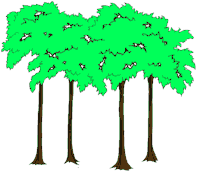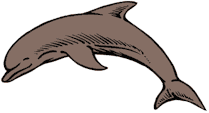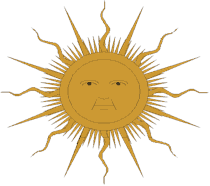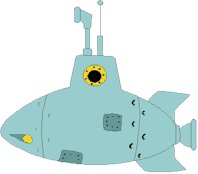Here are some ideas and suggestions for activities and starters you might like to try with your class during the Telecom Amazon Adventure.
 Idea 1
Idea 1Use an atlas or other aid to work out how far it is from New Zealand to Brazil. How far will Andrew travel in total during his adventure? (Remember to also find out how long the Amazon River is and include this in your calculations!).
Use a fax or phone to contact an airline and see how long a flight to Brazil would take. Does it go direct or does the flight stop off in other countries along the way? How much further is it than if it flew direct?
 Idea 3
Idea 3Andrew will not be able to use New Zealand dollars to pay for the things he needs while on his trip. He will have to use Reais, which is the Brazilian currency. The present exchange rate (discuss what this means) is NZ$1 for every 70 Reais. How many Reais would he get for NZ$100?
Find out the exchange rate of the New Zealand dollar and compare it with currencies from other countries (eg: Australian dollar, United States dollar, English pound). Do some conversions.
Design a travel brochure that a tourist operator would be able to use to attract visitors to Brazil or to the Amazon region. You may need to get information from local travel agents about the sorts of things that tourists are able to do and see there (how about using the telephone or sending a list of questions via fax?). The Internet would also be a good source of information. Try some of these sites for information on travel in the Amazon and Brazil.
| Bryan World Tours - Amazon Rainforest Amazon Rainforest Expedition |
http://www.bryanworldtours.com |
| Brazil Nature A home page of Brazilian ecotourism. |
http://www.brazilnature.com |
| On-Line Travel to Brazil Travel and Tourism in Brazil |
http://www.brol.com/~brol |
| Brazil Travel Guide World Factbook - information about Brazil |
http://www.infohub.com/TR |
| The Last Frontier Travel Company - Brazil | http://www.lastfrontiers.co.uk./brazil.htm |
| Eco-tourism in Brazil | http://www.ecovoyager.com/amadvrv.htm |
 Idea 5
Idea 5There are huge environmental concerns for the Amazon region, in particular deforestation (cutting down of the Amazon rainforests to create useable land for cattle farmers and other activities) and fishing of areas of the Amazon river, and the forced removal of native forest-dwellers and the Amazonian Indian population.
Research and present a report to the class on one of these issues. Some WWW pages that might help you are:
| Rainforest Facts Saving the Rainforest - A Complex Problem and a Simple Solution By Leslie Taylor |
http://rain-tree.com/fact |
| Interactive Ecotourism Game | http://www.geog.umn.edu/~schaller/ amazon/ecotourism/eco1.html |
| National Geographic | http://www.nationalgeographic.com |
| Rainforests in Peril | http://www.ran.org/ran/info_center/index.html |
| Rates of Destruction | http://www.ran.org/ran/info_center/rates.html |
| Amazon Indians Evicted | http://www.greenbuilder.com/mader/ planeta/0595/0595amaz.html |
| Amazon Indians to regain land | http://www.edf.org/pubs/EDF-Letter/1994/ Jan/a_amazon.html |
 Idea 6
Idea 6There are large numbers of interesting and unusual animals living in the Amazon region. See if you can find pictures of some of these animals in your library, draw them and colour them in, then make them into a wall frieze for your classroom.
Research and present a report on why scientists think the Amazon rainforest is so important to the world's climate. Use some of the Internet sites listed earlier or encyclopaedias from the library to help you find information for this.
 Idea 8
Idea 8The Amazon River has its own rare species of dolphin. It is thought by many tribes living along the river that the pink dolphin, or Boutu, has mystical and magical powers, and as such is "tubu" (not to be killed). Unfortunately, there are many illegal hunters who seek and kill the mammals for their teeth, eyes and other body parts, and the dolphins are now in danger of extinction.
Find out as much as you can about the Pink Dolphins of the Amazon River, and design and create a poster detailing why they are so special and how people can help to save them from extinction.
If you are in the junior school, you may like to cut out shapes of the pink dolphins from paper, staple two of the shapes together to make a "stuffable toy" and then assemble them as a hoop mobile to hang from the classroom ceiling.
One of the most interesting inhabitants of the Amazon River are Piranha. Piranha have very strong jaws with sharp, firmly anchored teeth which form a continuous jagged saw. They also have a saw-like belly and a spine in front of the dorsal fin. They hunt in schools and are capable of stripping the flesh off of an average sized human being in a matter of minutes!
Find some pictures and information on Piranha in the library or on the Internet. Download these, or if you can, scan images from books and use them in a slideshow presentation on Piranha - using a programme such as ClarisWorks. If you do not have access to a computer make up a "paper strip TV show" that provides as much information as you can about Piranhas. Include information such as where they live in the Amazon region, some of the myths about them, how they hunt, what they eat, the dangers they pose to humans, how big they are, what they look like etc.
There are a huge number of different animals and birds that live in the Amazon jungle and river area. Try to find out the names of as many as you can. Can you find one for each letter of the alphabet? Make up a wall mural with pictures (you will need to find out what they look like!) and names of as many animals as you can from the area. This list might help you:
| A – anaconda, anteater, armadillo | B – boa constrictor, birdwing, butterfly |
| C – crocodile, caiman (or cayman), capybara | D – dolphin |
| E – egret | F – frog (red-eyed), firefly |
| G – gulls | H – heron |
| I – ibis (bird) | J – jaguar |
| K – kinkajou | L – leaf-cutter ant, lizard |
| M – marabou stork, manatee | N – night monkey (or owl monkey) |
| O – ocelot, otter, ovenbird | P – parrot, piranha |
| Q – queixada (or peccary) | R – red howler monkey |
| S – sloth | T – tamarin, toucan, tarantula, tartaruga turtle |
| U – umbrella bird | V – vampire bat, vulture |
| W – weasel, whippoorwill | X – (the challenge animal) |
| Y – yapock (or water possum) | Z – zorro (or flag-tailed dog fox) |
Create a mural of a tropical rainforest and place animal cards in alphabetical order on the mural. Display the mural in the school hall or office area. Record interesting facts about the animals on the backs of the animal cards. Attach the cards to the mural so that they can be flipped over and read. Each day, post a new question about one of the animals to encourage students to look for answers on the back of the cards.
Pretend you are the animals you researched and tell about their life in the Amazon. Encourage the rest of the class to ask lots of questions.
Work as a group to classify the animals by amphibians, arachnids, birds, fish, insects, mammals, reptiles, and/or any other class they find.
Some of the early explorers of the region had to face enormous hardships including hostile natives, jungle diseases and dangerous animals as they went about exploring the Amazon River. Such people as Vicente Yáńez Pinzón in 1500 and Francisco de Orellana in 1540 carried out major explorations along the river, to pave the way for later scientific expeditions that are still going on to this day.
Imagine you were one of these first explorers. Make up a play or role play of your adventures as you explore the Amazon. You might like to do this in a group or as a whole class, with the various members taking parts as crew, natives or even animals!
One of the interesting features of the Amazon River is that in all of its 6275km there is not one single bridge going across it. This is because the region is prone to flooding and efforts to make bridges and other "fixed" structures have all failed. The main form of transport in the region is via boat or barge. In fact large ocean liners are able to sail nearly the whole length of the Amazon River!
Design and build a model of a barge that could be used to carry heavy loads across the Amazon River. Your barge must be able to carry a weight of at least 1kg without sinking. Some of the things you might use to make your barge could be egg cartons, popsicle sticks, ice cream containers, tape, straws, cotton reels, plastic bottles etc.
Find out about and research "eco-tourism". What is it and why is it so important in the Amazon region? Are there any examples of "eco-tourist" activities in New Zealand? Think about such tourist attractions as Whalewatch off the coast of Kaikoura - would activities such as these be able to be considered examples of eco-tourism?
Anthropologists (find out what anthropologists do!) think that there are still a number of undiscovered tribes living in unexplored regions of the Amazon jungle.
Imagine you are a member of one of these undiscovered tribes - design and create a ceremonial costume that represents the special character of your tribe (think of the "Cat People" of Manu National Park that Andrew will be reporting on in audioconference 5). Your costume may consist of a mask or other head gear, a ceremonial dress or gown, footwear etc.
 Idea 17
Idea 17Find out as much as you can about the Incas and where and how they lived. What was unusual and special about the Inca civilisation, and what do scientists think happened to them?
Prepare a project on the Incas and present this to the rest of the class.
During the early part of this century, Brazil was the centre of a worldwide rubber boom as the demand for rubber for making such things as car tyres and other rubber-based machinery parts grew. The Amazon boom ended when rubber plants were smuggled out of the Amazon, and used to establish big rubber plantations in Asia (where rubber could be produced much cheaper).
Research and prepare a report or project on what is now used in place of rubber in the manufacture of car tyres and similar products. Find out the ways in which rubber and substitute products are processed into the many goods and products we have today. Think of as many things as you can that use or are made from rubber - what are some of the characteristics of rubber that make it so special and important?
See if you can find out about some of the species of animals from the Amazon region that are considered endangered. Design a poster that provides information all about the animal you have selected to help educate people about why they should help to protect and preserve it.
 Idea 20
Idea 20Some of the areas of the Amazon River itself have yet to be explored. The river is very deep and extremely dangerous in places, making any real attempt to explore and discover its secrets almost impossible. Imagine you are a designer, and design and draw up plans of an underwater vessel that you can use to explore the depths of the Amazon River. It should have devices that can pick up objects from the bottom of the river, or collect samples of any unusual plants or life forms for later study. Remember to build in to your vessel good motors and steering so that you are able to manoeuvre your craft.
Be creative! Can you help Andrew keep in touch?
One of the problems Andrew will be having as he goes about his journey is to make sure he is near a telephone so that he is able to make his audioconference calls. He will also be taking his laptop computer with him so that he can update the Internet pages.
Design and draw up plans of a device that Andrew can take to allow him to keep in touch with us throughout all his journey. He should be able to make calls to us no matter where he is (take a look at his itinerary to see the types of places the machine needs to operate from) and be able to log on to the Internet to send us emails and update the home page.
 Idea 22
Idea 22Find out as much as you can about "The Water Cycle". Why is the Amazon Rainforest area in Brazil such an important part of the world's Water Cycle?